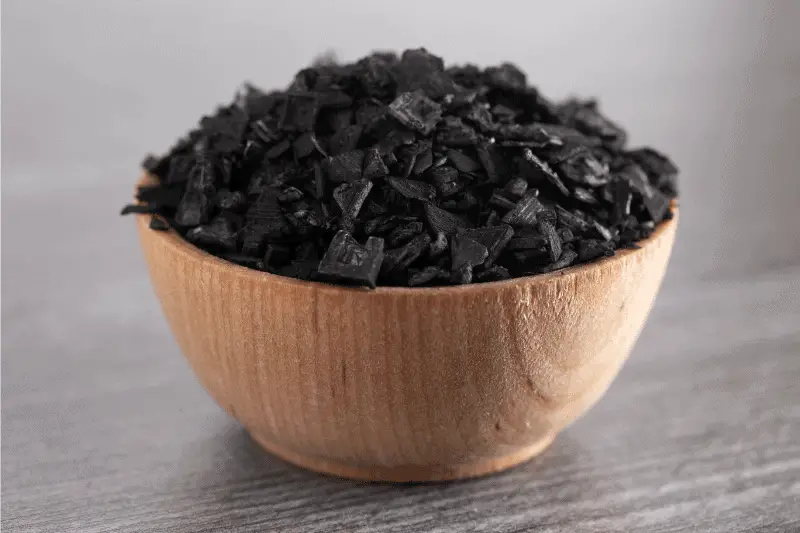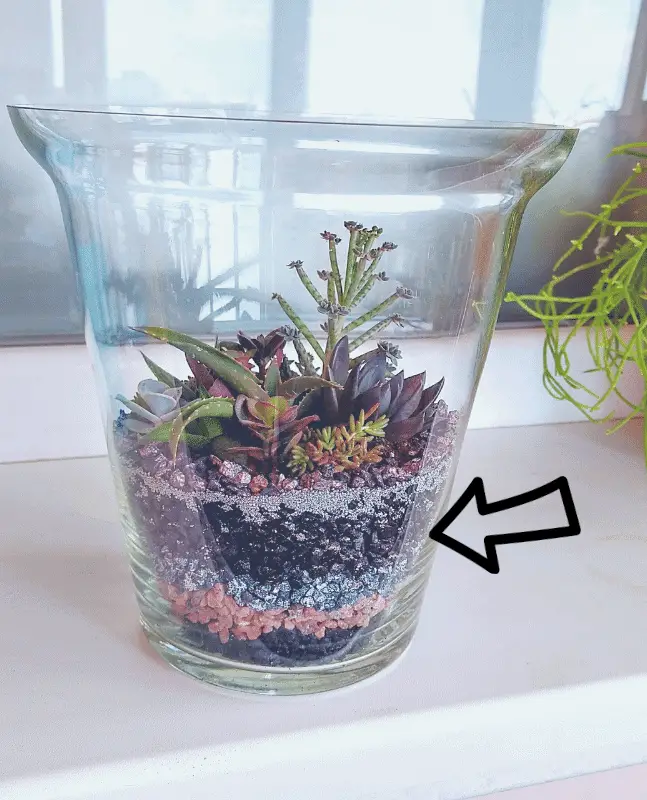This page may contain affiliate links that allow us to make a small commission from qualifying purchases (at no extra cost to yourself). We appreciate your support.
Terrariums are filled with beautiful plants and crystal clear water. However, your terrarium can turn into a bowl of toxins, bacteria, and rotten roots without the proper layers. Adding filtration and natural sanitization is crucial, so many terrarium owners consider charcoal to be an essential additive.
Terrariums need charcoal to remove toxins from the water, foul odors from decaying debris, and enhance the filtration process. Plants that decay in the terrarium will cause a buildup of smells and toxins that can make it hazardous for the living plants. Charcoal should be between the soil and rocks.
In this article, we’ll show you why charcoal provides significant benefits to your terrarium, how you can use it in between the layers, and how long it lasts. We’ll also discuss a couple of potential alternatives.

#1 Charcoal Removes Toxins From Terrariums
You might’ve seen countless bloggers debate the effectiveness of using charcoal in terrariums. Some say it’s useless, while others say it’s irreplaceable. While the debate is ongoing, there’s no denying the following three reasons charcoal can fight toxins in a terrarium:
- Charcoal naturally breaks down bacteria and toxins. Decaying organic matter in the terrarium will eventually need filtration. Charcoal destroys the bacteria, preventing the terrarium from being toxic for the plants to thrive.
- These toxins can eat the plants’ leaves, roots, and stems. If you don’t get rid of the toxins with charcoal (or one of the alternatives mentioned later on this page), your plants will break down and need to be replaced.
- Failure to change the charcoal can worsen the terrarium. Charcoal is incredibly beneficial, but it can also become the worst thing for the tank if you don’t switch it with new, fresh charcoal. It’ll get saturated and grow mold while failing to filter anything.
As you can see, charcoal’s ability to fight toxins is an excellent pro for your terrarium. It’s relatively inexpensive, easy to add, and as effective as it gets.
#2 Charcoal Can Fight Foul Terrarium Odors
Are you tired of your terrarium smelling like a dirty pond? Nature runs its course in large bodies of water, but it can be quite potent in a small container. Charcoal is known to balance odors caused by decaying organic materials, which is why it’s a great choice for terrariums of all sizes.
The decaying and filtration process is very slow. While rocks, mesh, and other solutions will filter the tank, nothing works as well for foul scents as a thin charcoal layer.
#3 Terrarium Charcoal Promotes Filtration and Aeration
Perhaps the best benefit for plant growth is that charcoal can filter old debris and promote oxygen for the roots. Your plants will be loaded with nutrients, allowing them to grow quickly and healthily.
Here’s how charcoal filters your terrarium:
- Charcoal is porous and collects debris. The lightweight material lets the water pour through it without allowing the debris to go through to the other side. Once it’s trapped, the debris can’t float back up to the plants.
- Aeration is crucial for healthy root growth. If you want your plants to stay healthy and free of fungus and bacteria, they need proper aeration. Charcoal is ideal since it’s not airtight.
Whether you’re trying to remove funky smells or wanting to grow healthier plants, charcoal is a top-notch terrarium solution. Read on to understand the difference between activated and horticultural charcoal and to learn how to use it and where to place it in your tank.
Activated vs Horticultural Charcoal: What’s the difference?
When it comes to charcoal for terrariums there are two main types: Activated charcoal and Horticultural charcoal. Although the two types have similarities, continue reading to learn which charcoal type may be best for you.
Activated Charcoal (Active Carbon)
Activated charcoal is a processed form of carbon and is heated at much higher temperatures than Horticultural Charcoal. Activated charcoal tends to be the more common choice for terrariums due to its higher filtration capabilities and ability to absorb higher rates of toxins and other impurities. Activated charcoal is better suited for closed terrariums due to their high humidity levels.
Activated charcoal can come in a variety of forms such as powder, pellets, tubes, and pebbles. Powder is often used when mixing with your substrate, whereas the other forms are typically used when creating a charcoal layer within your terrarium.
If your looking to purchase the best activated charcoal, try searching on Etsy, as they have a large variety of activated charcoal forms for you to choose from.
Pros:
- Higher filtration and absorption
- Comes in a variety of forms
- More effective at reducing odors and removing toxins
- Great for closed terrariums
Cons:
- Does not remain activated forever and needs regular changing (every 2-4 weeks)
- Not as effective for open terrariums
- More expensive than Horticultural Charcoal
Horticultural Charcoal (Inactive Carbon)
Horticultural charcoal is an unprocessed form of carbon treated at very low temperatures. It is made from Pyrolyzed organic material such as hardwood. Although horticultural charcoal is not the best choice for filtration purposes, this charcoal can still act as a good drainage medium and provide good aeration for your soil. Even though Horticultural charcoal is better suited for open terrariums, it can still provide benefits for a closed terrarium.
If you’re looking for a top-of-the-line charcoal bag for a terrarium, try the Horticulture Charcoal by Perfect Plants on Amazon. This 24-ounce bag comes with more than enough charge for a few changes, keeping your terrarium in good condition for many months down the road.
Pros:
- Better suited for creating a drainage layer
- Great at creating more surface space for beneficial bacteria to accumulate.
- Better at retaining oxygen in soil
- Cheaper than Activated Charcoal
- Doesn’t not need to be replaced as often
Cons:
- Lack of absorption capacity
- Lack of filtration capabilities
- Can raise water PH levels
Where Do You Put the Charcoal In a Terrarium?
If you want to use charcoal in your terrarium, it needs to go between the rocks and the soil. The top layer should be the water and plants, followed by a layer of soil, charcoal, and rocks. The rocks add another layer of filtration, which works very well with charcoal.
I recommend using a one-inch layer of charcoal for the best results. Too much charcoal can clog the tank and won’t leave enough room for the soil and rocks. On the other hand, too little charcoal won’t provide all of the previously mentioned benefits.

How Long Does Charcoal Last?
Charcoal can last for quite a long time, but its longevity is cut down when it’s used in a terrarium. Charcoal filters are used in fish tanks, drinking water systems, and terrariums, but they have to be changed frequently. Activated charcoal needs to be changed once every 2-4 weeks.
Some terrariums become dirtier than others, requiring changes bi-weekly. The best way to know when it’s time to change the charcoal is if it looks swollen or the odors return to the terrarium. Having a clear terrarium makes it easier to know the charcoal’s condition.
Another indicator of worn charcoal is to look at the rock layer for signs of debris. If there’s a ton of algae and bacteria on the bottom rock layer, it means the charcoal isn’t filtering as much as it could.
What Can You Use Instead of Charcoal? Alternatives?
If you don’t want to use charcoal, you’re not out of luck. Try these alternatives:
- Sphagnum moss: Dried, cleaned moss is a great choice because it provides a slightly less dense filtration than charcoal. If you find charcoal to be a bit too dense, it could clog the roots and prevent them from growing. Switching to sphagnum moss could make a world of difference.
- A fabric barrier: Measure the layer’s dimensions (length x width), cut a porous nylon strip, and layer it where the charcoal would be. Nylon won’t remove odors and toxins, but it can aerate the roots for better plant growth.
Final Thoughts
Now that you know how helpful charcoal can be for your terrarium, it’s up to you to decide if it’s worth it. As long as you add a thin layer of charcoal below the soil and above the rocks, it’ll filter toxins and odors to promote a healthy living environment. Remember to change the charcoal every month for the best results.

Meet Brad, the creator behind Vivarium Vibes, where his deep connection with nature and animals truly comes to life.
